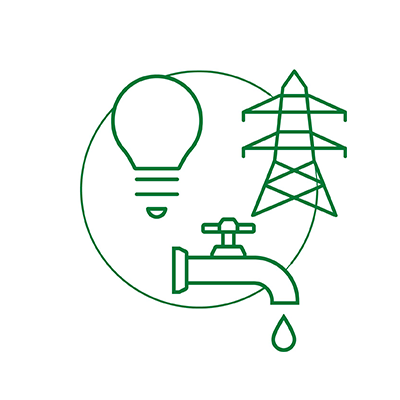Earth System Modeling
for Grid Decarbonization
Earth System Modeling
for Grid Decarbonization
Helping policymakers
and emergency planners
achieve an energy future
that is resilient.
Helping policymakers
and emergency planners
achieve an energy future
that is resilient.
Pacific Northwest National Laboratory (PNNL) leads in modeling interdependencies across spatial scales and prioritizes research areas that are aligned with the needs of the energy sector while considering environmental health and societal well-being. These capabilities help grid operators, policymakers, and other decision-makers understand changes and risks involved in the energy sector.
PNNL modeling experts develop and deploy tools to make informed decisions that consider the pressures of climate change, an increasing global population, and growing water and energy demands. In its unique approaches, PNNL also co-develops community tools and capabilities with numerous partners to provide ultimate impact. By cooperatively developing new hierarchical modeling frameworks and coupling approaches, PNNL addresses complex questions across spatial scales aimed at creating a more resilient world.
Need access to datasets or other models? Check out the Climate Research Portal.
|
|
Water Management |
Distribution system resilience
FOR GRID OPERATORS
EGRASS
Identify optimal backup power sources for recovery of critical end-use loads
Water management
fOR researchers
WM, WMP
Regulates river streamflow through the representation of dam operations and water extractions, and normalizes return flow for irrigation and non-irrigation. Includes process-based hydropower model.
Hydropower and thermoelectric generation constraints
fOR RESEARCHERS
hydrofixr
Statistical processing of either WM-simulated or observed flow release or storage into hydropower and thermoelectric datasets
Global water availability
FOR researchers
GCAM-Xanthos
Global estimates of renewable fresh-water resources, including runoff, streamflow, and hydropower potential; and thermoelectric constraints.
Thermoelectric capacity
FOR water-storage reservoir simulation in texas
capraTX
Simulates water-storage reservoirs providing cooling water to thermal power plants in the ERCOT
* Indicates co-developed community tool
 |
Hydrology |
Distributed hydrology soil vegetation modeling
For engineering design curves; evaluating tradeoffs
DHSVM
High-resolution, distributed-surface hydrology
Continental-scale river routing
FOR researchers
MOSART
Grid-scale based, scale-adaptive continental river routing; support distributed water availability studies
Macro-scale surface hydrology
for forecasters, researchers, water managers
VIC*
Continental-scale physics-based hydrologic model that represents energy balance
Soil and water assessment
for researchers, water, and agricultural stakeholders
SWAT*
River-basin scale model to understand soil-water interactions
* Indicates co-developed community tool
|
|
Extreme Weather Resilience |
Flood predictability
for researchers, emergency response planners
RIFT
Rapidly predict flood extents to characterize infrastructure impacts
Hurricane risk
for researchers, emergency response planners
RAFT
Project changes in hurricane intensity, frequency, and land-falling location to evaluate hurricane impacts on coastal regions
Rapid damage analytics
for grid planners and emergency managers
RADR
Actionable insights using image analytics derived from optical and radar-based remotely-sensed imagery
 |
Water and Energy Demand |
Electricity load prediction
for energy research forecasters
TELL**
Generate hourly total electricity load predictions for every county in the continental United States.
Water demand prediction
for researchers
GCAM-Tethys
Sectoral water demand prediction; withdrawal datasets
** Indicates model still under development
|
|
Land Use |
Land use, land cover downscaling
for researchers; land use planners
DEMETER
Disaggregate projections of future land allocations generated by integrated human-Earth system models
Biomass assessment
for researchers
BAT
Determine where biomass production can occur and how much resource is required, assess tradeoffs
Agricultural water demand management
for RESEARCHERS
WM-ABM
Represent agricultural human decision-making for multisector analysis; deploy alongside modeled representations of physical systems
Electricity system capacity expansion downscaling
FOR ENERGY PLANNERS, RESEARCHERS
CERF
Identify feasible, site-specific locations for individual new power plants
Community land modeling
FOR RESEARCHERS
CLM*
Global-scale representation of land surface-hydrology processes, capable of simulating anthropogenic influences on the terrestrial hydrological budget
* Indicates co-developed community tool
 |
Earth Systems |
Community Earth modeling
for researchers
E3SM*
Modeling Earth system variability and change
Weather research and forecasting
for forecasters, researchers, and energy and water planners
WRF*
Numerical weather prediction for atmospheric research and operational forecasting
* Indicates co-developed community tool